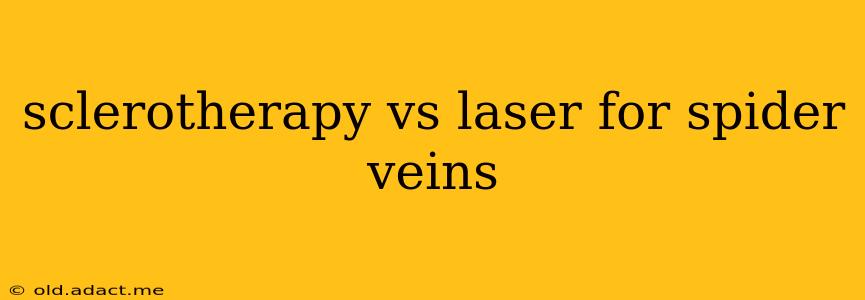Spider veins, those unsightly, thin, bluish or reddish veins that often appear on the legs, can be a source of cosmetic concern for many. Fortunately, there are effective treatments available, with sclerotherapy and laser treatment being two of the most popular options. Choosing between them depends on several factors, and understanding the nuances of each procedure is crucial for making an informed decision. This comprehensive guide will delve into the differences between sclerotherapy and laser treatment for spider veins, helping you determine which approach is best suited for your individual needs.
What is Sclerotherapy?
Sclerotherapy is a minimally invasive procedure that involves injecting a solution directly into the spider vein. This solution, a sclerosant, irritates the lining of the vein, causing it to collapse and eventually fade from view. Over time, the blood is re-routed through healthier veins, and the treated vein is absorbed by the body.
Advantages of Sclerotherapy:
- High Success Rate: Sclerotherapy boasts a high success rate in eliminating spider veins, often resulting in significant improvement in appearance.
- Minimally Invasive: It's a relatively simple procedure with minimal discomfort, often requiring only local anesthesia.
- Cost-Effective: Compared to some laser treatments, sclerotherapy can be a more affordable option.
- Suitable for Various Vein Sizes: It can effectively treat a wider range of vein sizes than laser therapy.
Disadvantages of Sclerotherapy:
- Multiple Sessions May Be Needed: Complete vein clearing often requires multiple treatment sessions spaced several weeks apart.
- Potential Side Effects: While rare, side effects such as bruising, swelling, and temporary skin discoloration can occur.
- Not Suitable for All Vein Types: Sclerotherapy may not be as effective for larger varicose veins.
What is Laser Treatment for Spider Veins?
Laser treatment uses intense pulsed light (IPL) or laser energy to heat and destroy the spider veins. The heat causes the vein walls to collapse and the blood to be reabsorbed by the body. This results in the vein becoming less visible or disappearing altogether.
Advantages of Laser Treatment:
- Quick Treatment Time: Laser treatments are often faster than sclerotherapy sessions.
- Minimal Downtime: Recovery time is typically shorter compared to sclerotherapy.
- Good for Small Veins: Laser treatment is particularly effective for smaller spider veins and superficial telangiectasia.
- Improved Skin Texture: Some laser treatments can also improve skin texture and tone as a secondary benefit.
Disadvantages of Laser Treatment:
- Higher Cost: Laser treatments are generally more expensive than sclerotherapy.
- May Require Multiple Sessions: Multiple sessions may be needed for optimal results, similar to sclerotherapy.
- Potential Side Effects: Potential side effects include bruising, swelling, blistering, and changes in skin pigmentation.
- Not as Effective for Larger Veins: Laser treatments are generally less effective for larger or deeper veins.
Which Treatment is Better for Me?
The best treatment for you depends on several factors, including:
- Size and Location of the Veins: Sclerotherapy is often preferred for larger veins, while laser treatment is better suited for smaller, superficial veins.
- Your Skin Type: Certain skin types may respond better to one treatment over the other.
- Your Budget: Sclerotherapy is generally more affordable than laser treatment.
- Your Pain Tolerance: Both procedures are relatively painless, but individuals with low pain tolerance may find sclerotherapy more comfortable.
- Your Doctor's Recommendation: A consultation with a dermatologist or phlebologist is crucial to determine the most appropriate treatment plan.
How Much Does Each Treatment Cost?
The cost of sclerotherapy and laser treatment can vary depending on several factors, including the number of veins being treated, the size of the treatment area, the clinic's location, and the physician's fees. It's best to consult with your healthcare provider for an accurate cost estimate.
What are the Risks and Side Effects?
Both sclerotherapy and laser treatment carry minimal risks. However, potential side effects, while uncommon, can include bruising, swelling, discoloration, and pain. These side effects are typically temporary and resolve within a few weeks. A consultation with a qualified healthcare professional is essential to discuss potential risks and side effects specific to your individual situation.
How Long Does it Take to See Results?
The results of both sclerotherapy and laser treatment are not immediate. It may take several weeks or even months to see the full effects of the treatment, as the treated veins gradually fade and are absorbed by the body. Multiple sessions may be necessary to achieve optimal results.
Are There Alternatives to Sclerotherapy and Laser Treatment?
Yes, other less common treatment options exist for spider veins, but sclerotherapy and laser treatment remain the most popular and effective methods. Your doctor can discuss these alternatives if appropriate for your individual circumstances.
By carefully considering the advantages and disadvantages of each procedure and consulting with a qualified healthcare professional, you can make an informed decision about the best treatment option for your spider veins. Remember, the goal is to achieve safe, effective, and aesthetically pleasing results that improve your confidence and overall well-being.
